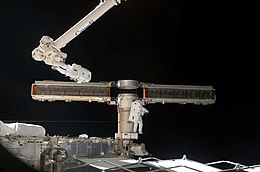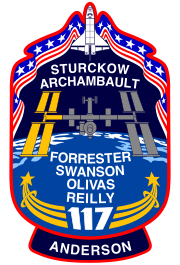 Reilly (left) and Olivas (center) during EVA 3, preparing the folded P6 truss for its relocation | |
| Names | Space Transportation System-117 |
|---|---|
| Mission type | ISS assembly |
| Operator | NASA |
| COSPAR ID | 2007-024A |
| SATCAT no. | 31600 |
| Mission duration | 13 days, 20 hours, 12 minutes, 44 seconds |
| Distance travelled | 9,300,000 kilometres (5,800,000 mi)[1] (9,334,000 km) |
| Orbits completed | 219 |
| Spacecraft properties | |
| Spacecraft | Space Shuttle Atlantis |
| Launch mass | 2,052,719 kilograms (4,525,471 lb) (total)[2] 122,683 kilograms (270,469 lb) (orbiter) |
| Landing mass | 90,492 kilograms (199,501 lb) |
| Crew | |
| Crew size | 7 |
| Members | |
| Launching | |
| Landing | |
| Start of mission | |
| Launch date | June 8, 2007, 23:38:04 UTC |
| Launch site | Kennedy, LC-39A |
| End of mission | |
| Landing date | June 22, 2007, 19:49:38 UTC |
| Landing site | Edwards, Runway 22 |
| Orbital parameters | |
| Reference system | Geocentric |
| Regime | Low Earth |
| Perigee altitude | 334 kilometres (208 mi)[3] |
| Apogee altitude | 354 kilometres (220 mi) |
| Inclination | 51.6 degrees |
| Period | 91.4 minutes |
| Docking with ISS | |
| Docking port | PMA-2 (Destiny forward) |
| Docking date | June 10, 2007, 19:36 UTC |
| Undocking date | June 19, 2007, 14:42 UTC |
| Time docked | 8 days, 19 hours, 6 minutes |

 (left to right) Anderson, Reilly, Swanson, Sturckow, Archambault, Forrester and Olivas. | |
STS-117 (ISS assembly flight 13A) was a Space Shuttle mission flown by Space Shuttle Atlantis, launched from pad 39A of the Kennedy Space Center on June 8, 2007. Atlantis lifted off from the launch pad at 19:38 EDT. Damage from a hail storm on February 26, 2007, had previously caused the launch to be postponed from an originally-planned launch date of March 15, 2007. The launch of STS-117 marked the 250th orbital human spaceflight.[4] It was also the heaviest flight of the Space Shuttle.
Atlantis delivered to the International Space Station (ISS) the second starboard truss segment (the S3/S4 Truss) and its associated energy systems, including a set of solar arrays. During the course of the mission the crew installed the new truss segment, retracted one set of solar arrays, and unfolded the new set on the starboard side of the station. STS-117 also brought Expedition 15 crewmember Clayton Anderson to the station, and returned with ISS crewmember Sunita Williams.
On June 11, 2007, NASA mission managers announced a two-day extension of the mission, adding a fourth extra-vehicular activity (EVA). These two days were inserted into the mission timeline after flight day 8. This possibility had been discussed prior to launch. Because of launch day and thus rendezvous day uncertainty the decision to extend was deferred until after launch. The repair of the gap in the Orbital Maneuvering System (OMS) thermal blanket (heat shielding) was conducted during EVA 3.[5][6]
STS-117 remains the longest mission for Atlantis because of the cancellation of landing opportunities on June 21, 2007, due to bad weather. Atlantis landed at Edwards Air Force Base on June 22, 2007.
- ^ NASA (June 22, 2007). "STS-117 Mission Status Report #30". Archived from the original on November 26, 2010. Retrieved July 26, 2010.
- ^ NASA. "STS-117 – Building on Experience" (PDF). Archived (PDF) from the original on October 8, 2021. Retrieved August 7, 2010.
- ^ National Space Science Data Center/World Data Center for Satellite Information (July 1, 2007). "SPACEWARN Bulletin No. 644". NASA. Archived from the original on March 21, 2021. Retrieved August 9, 2010.
- ^ "STS-117 marked 250th orbital crewed flight". collectSPACE. June 8, 2007. Archived from the original on March 18, 2010. Retrieved July 27, 2010.
- ^ Mark Carreau (June 12, 2007). "Repair to lengthen Atlantis' flight". Houston Chronicle. Archived from the original on May 21, 2011. Retrieved July 27, 2010.
- ^ "STS-117 MCC Status Report No. 14". NASA. June 15, 2007. Archived from the original on November 26, 2010. Retrieved July 27, 2010.